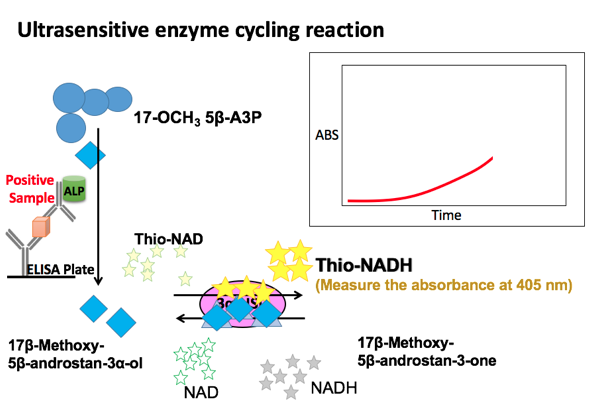開發新型免培養之結核菌抗原檢測方法
開發新型免培養之結核菌抗原檢測方法
根據疾病管制局統計,台灣地區每年約有1萬2千例左右之結核菌感染病例。在臨床上,耐酸性染色結核菌鏡檢、固態細菌培養基及MGIT960自動化液態培養基系統為主要的檢驗方式,但因為結核菌的分裂速度緩慢,因此病患痰液中之結核菌在進行培養試驗時,需要3-8週的等待時間。而這段時間常常會造成防疫上的漏洞或延誤病情的治療。本研究與日本TAUNS公司及早稻田大學伊藤悅朗教授實驗室合作,進行高敏感度結核菌抗原酵素免疫分析方法之開發。其主要原理是利用酶迴圈反應提高結核分枝桿菌受熱衝擊後分泌出的微量MPB64蛋白質的訊號強度,通過檢測MPB64蛋白質可以確定痰液標本中是否存在結核分支桿菌。研究結果發現,其偵測極限可以到達100 CFU/mL。
圖形摘要

酶迴圈反應之原理。當待測檢體含有MPB64蛋白質時,抗MPB64抗體上之ALP酵素會被保留在96-well微孔盤中。此時加入的substrate A中之17-OCH35b-A3P會被去磷酸化變成17b-Methoxy-5b-androstan-3a-ol。當Thio-NAD與17b-Methoxy-5b-androstan-3a-ol同時存在時則會被3a-HSD轉變成Thio-NADH與17b-Methoxy-5b-androstan-3a-one。此時偵測O.D. 405/660 nm就可以測量且定量Thio-NADH累積的情形,因此就可以推估結核菌的濃度。
應用與亮點:
1. 快速且簡易的結核病檢測試劑可以在一天之內進行結核病確診
2. 偵測極限可以到達100 CFU/mL
3. 安全及正確檢驗結核菌的工具將可提供病患適合的治療資訊,提升結核病防治成效。
【研究團隊】
團隊成員:盧柏樑 王文宏
代表單位:高雄醫學大學醫學系 感染內科
團隊簡介:
高醫附院感染內科實驗室,主要積極推動有關感染症全方位的臨床檢驗與研究,包括特殊傳染暨感染疾病之檢驗及鑑定,並協助院內感染管制、毒性基因表現及抗生素抗藥性偵測等研究。
研究聯繫Email:d830166@gmail.com ; bole0918@gmail.com
【論文資訊】
論文出處:A novel, rapid (within hours) culture-free diagnostic method for detecting live Mycobacterium tuberculosis with high sensitivity., EBioMedicine, 60, 103007, October 01, 2020
全文下載:https://www.thelancet.com/journals/ebiom/article/PIIS2352-3964(20)30383-2/fulltext
Culture-Free ultrasensitive mycobacterium tuberculosis detection ELISA
Culture-Free ultrasensitive mycobacterium tuberculosis detection ELISA
Tuberculosis (TB) is a disease caused by bacteria that are spread through the air from person to person. According to the reports from Taiwan Centers for Disease Control, there were 11,000 cases TB infection each year and 600 of those cases result in deaths in Taiwan. Clinically, the bacteriology examination is the major testing for tuberculosis diagnosis including acid-fast staining microscopy examination, MGIT culture testing, strip speciation and polymerase chain reaction for genome of mycobacterium. Because the slow growth rate of Mycobacteria tuberculosis, the bacteria culture for TB diagnosis usually take 4-8 weeks incubation period. A quick, safe and correct testing for tuberculosis will help patients receive appropriate treatment and prevention the spread of M. tuberculosis. In this research, Professor Po-Liang Lu in KMU, Professor ITO Etsuro in Waseda University and Japan TAUNS Laboratories Inc. cooperate to develop the culture-free TB detection ELISA method. The enzyme cycling reaction is used to detect MBP64 protein which is secreted by live Mycobacteria tuberculosis. The results showed that the detection limitation of culture-free ultrasensitive TB detection ELISA is 100 CFU/ml.

Characteristics of ultrasensitive ELISA combined with the enzyme cycling reaction. After proceed the conventional ELISA, the ALP-labeled enzyme will retain in the 96-well plate. And then, the coloring reagent was added into the wells. The 17-OCH35b-A3P in the solution will be dephosphorylated by ALP into 17b-Methoxy-5b-androstan-3a-ol. In thr presence of Thio-NAD, 17b-Methoxy-5b-androstan-3a-ol will be converted into 17b-Methoxy-5b-androstan-3a-one by 3a-HSD. Thio-NADH is formed at the same time, which is then measured at 405/660 nm.
Application and Highlights:
1. A novel, rapid (same day) diagnostic method for detecting M. tuberculosis with high sensitivity.
2. The detection limitation of this method is about 100 CFU/ml.
3. A quick, safe and correct testing for tuberculosis will help patients receive appropriate treatment and prevention the spread of M. tuberculosis.
Research Team Members: Po-Liang Lu, Wen-Hung Wang
Representative Department: Division of Infectious Disease, Internal Medicine, Kaohsiung Medicine University Hospital.
Introduction of Research Team:
The research of division of Infectious Diseases Lab involve in development of new diagnosis methods for infectious disease, including tuberculosis, dengue virus and respiratory syndrome coronavirus 2. We also focus on antimicrobial drug resistance analysis, and virulence gene expression and cell viability studies, too.
Contact Email: d830166@gmail.com ; bole0918@gmail.com
Publication: A novel, rapid (within hours) culture-free diagnostic method for detecting live Mycobacterium tuberculosis with high sensitivity., EBioMedicine, 60, 103007, October 01, 2020
Full-Text Article: https://www.thelancet.com/journals/ebiom/article/PIIS2352-3964(20)30383-2/fulltext

